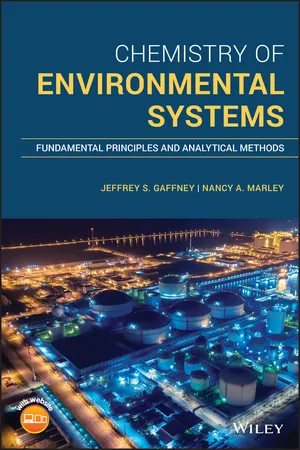
Chemistry of Environmental Systems
Fundamental Principles and Analytical Methods
- English
- ePUB (mobile friendly)
- Available on iOS & Android
Chemistry of Environmental Systems
Fundamental Principles and Analytical Methods
About This Book
A modern guide to environmental chemistry Chemistry of Environmental Systems: Fundamental Principles and Analytical Methods offers a comprehensive and authoritative review of modern environmental chemistry, discussing the chemistry and interconnections between the atmosphere, hydrosphere, geosphere and biosphere. Written by internationally recognized experts, the textbook explores the chemistries of the natural environmental systems and demonstrates how these chemical processes change when anthropogenic emissions are introduced into the whole earth system. This important text:
- Combines the key areas of environmental chemistry needed to understand the sources, fates, and impacts of contaminants in the environment
- Describes a range of environmental analytical methodologies
- Explores the basic environmental effects of energy sources, including nuclear energy
- Encourages a proactive approach to environmental chemistry, with a focus on preventing future environmental problems
- Includes study questions at the end of each chapter
Written for students of environmental chemistry, environmental science, environmental engineering, geoscience, earth and atmospheric sciences, Chemistry of Environmental Systems: Fundamental Principles and Analytical Methods covers the key aspects and mechanisms of currently identified environmental issues, which can be used to address both current and future environmental problems.
Frequently asked questions
Information
1
Introduction to Environmental Chemistry
1.1 What is Environmental Chemistry?
1.2 Anthropogenic Pollution

Comparing the air of cities to the air of deserts and arid lands is like comparing waters that are befouled and turbid to waters that are fine and pure. In the city, because of the height of its buildings, the narrowness of its streets, and all that pours forth from its inhabitants and their superfluities… the air becomes stagnant, turbid, thick, misty, and foggy… If there is no choice in this matter, for we have grown up in the cities and have become accustomed to them, you should… select from the cities one of open horizons… endeavor at least to dwell at the outskirts of the city… If the air is altered ever so slightly, the state of the Psychic Spirit will be altered perceptibly. Therefore you find many men in whom you can notice defects in the actions of the psyche with the spoilage of the air, namely, that they develop dullness of understanding, failure of intelligence and defect of memory…

Table of contents
- Cover
- Table of Contents
- About the Authors
- Preface
- Acknowledgments
- Supplementary Material
- 1 Introduction to Environmental Chemistry
- 2 Atmospheric Composition and Basic Physics
- 3 The Fundamentals of Photochemistry
- 4 Chemistry of the Stratosphere
- 5 Chemistry of the Troposphere
- 6 Aerosols and Cloud Chemistry
- 7 Analytical Methods for Air Analysis
- 8 Chemistry of Surface and Ground Waters
- 9 Analytical Methods for Water Analysis
- 10 Fossil and Biomass Fuels
- 11 Climate Change
- 12 Nuclear Energy
- 13 Future Energy Sources and Sustainability
- Appendix A: Answers to Study Problems
- Appendix B: List of U.S. EPA Hazardous Air Pollutants – Air Toxics
- Appendix C: Henry's Law Constants (Hx) for Selected Inorganic and Organic Compounds
- Appendix D: Organic Water Pollutants, their Chemical Structures, Sources, and Concentration Limits in U.S. Drinking Water
- Appendix E: Chemicals Used in the Hydraulic Fracturing of Oil Shales for Natural Gas Extraction
- End User License Agreement